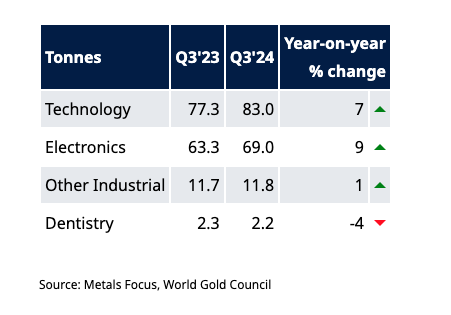Gold Demand in Tech and Industry Up in Q3
Gold is fundamentally money, but there is demand for the yellow metal in industry and technology.
Industrial and tech demand accounted for 83 tons of gold in the third quarter, a 7 percent year-on-year increase. It was a 2-ton increase quarter to quarter.
So far, in 2024, about 245 tons of gold have been consumed in industrial and technical applications.

The vast majority of industrial gold demand comes from the electronics sector. Sixty-nine tons of gold was used in electronics production in Q3, a 9 percent increase on an annual basis.
The three major Eastern electronics fabrication hubs all reported an annual increase in Q3 gold demand:
- Japan - 20 percent
- South Korea - 20 percent
- Mainland China and Hong Kong SAR - 10 percent
Meanwhile, U.S. electronic manufacturers recorded a 4 percent year-on-year decrease.
All the major smartphone companies unveiled new products in Q3, and smartphone shipments increased for the fifth consecutive quarter, but according to IDC, a market intelligence company, the industry is taking a "cautious" stance for the remainder of the year with some emerging signs of economic slowdown.
On the positive side of the equation, the ongoing adoption of 5G and a push for AI-enabled phones lifted gold demand in the wireless sector.
AI is the primary growth driver in the electronics sector, and it pushed another strong quarter in printed circuit boards (PCBs). Automotive electronics also use high-end PCBs to guarantee reliable operation in safety-critical functions.
Low-earth orbit satellites are also increasing demand for PCBs. According to the World Gold Council, the proliferation of satellites for communications and internet service may represent a potential long-term source of demand for gold from both PCB and wireless components.
Gold is also an input in the production of light-emitting diodes (LEDs). The amount of gold used in this sector increased modestly in Q3, fueled by increased adoption in the automobile sector.
Other industrial applications used about 12 tons of gold in Q3. This was almost identical to the Q3 2023 offtake and up 1 ton over the second quarter.
Gold Is a Useless Metal?
Warren Buffett once said, “Gold gets dug out of the ground in Africa or someplace. Then we melt it down, dig another hole, bury it again, and pay people to stand around guarding it. It has no utility. Anyone watching from Mars would be scratching their head.”
You’ll often hear this notion that gold is “useless” from commentators on mainstream financial networks.
As you can see by the growing demand for gold in technology and electronics, this is just silly.
In fact, gold is one of the most useful metals in the world. Due to its utility coupled with its scarcity, gold is also one of the most valuable metals in the world.
In the first place, gold is beautiful. That’s why people all over the world love to wear gold. About three-quarters of gold demand is for jewelry production. About 479.4 tons of gold were used in jewelry fabrication in the second quarter alone.
But gold isn’t just pretty. Gold's inherent physical and chemical properties make it useful in many industrial and technological applications. Gold doesn’t corrode, it is an exceptional electricity conductor, it is malleable, and gold can be used to catalyze many chemical processes without being consumed.
This is why we see gold increasingly used in the tech sector. In fact, gold would probably be used even more if it weren’t so rare and expensive.
Gold is also important in the medical field. Its inherent stability and unique optical properties make it perfect for use in diagnostic testing. The World Gold Council said that gold is “at the heart of the hundreds of millions of Rapid Diagnostic Tests (RDTs) that are used globally every year.
“This well-established and critically important technology has changed the face of disease diagnosis in the developing world over the last decade.”
Gold nanoparticles are used in testing for malaria, HIV, hepatitis, and other illnesses.
Gold has even been used in some exotic applications. In 2018, a team of Chinese researchers partially restored the sight of blind mice by replacing their deteriorated photoreceptors – sensory structures inside the eye that respond to light – with nano-wires made of gold and titanium.
The point is gold is far from useless.
But fundamentally, gold is money. And everybody wants to have money - especially real money.
*********






 Mike Maharrey is a journalist and market analyst for
Mike Maharrey is a journalist and market analyst for 









